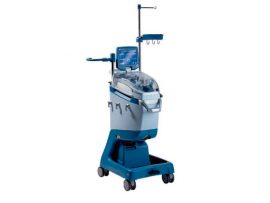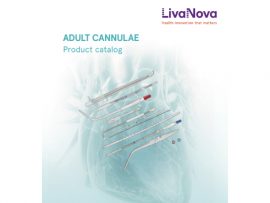Abstract To explore the challenges and describe the impact of the COVID-19 pandemic on intensive care nurses' experience in providing ECMO care in a high-volume Australian ICU ECMO centre that..
Read MoreAbstract Rationale: Life-threatening airway obstructions caused by tumors demand prompt and effective intervention. Traditional surgical methods are often complicated by bleeding risks, especially with the use of anticoagulation during extracorporeal..
Read MoreAbstract Background Donation after circulatory death (DCD) heart transplants have increased in the United States with direct procurement with machine perfusion (DPP) and thoracoabdominal normothermic regional perfusion (TA-NRP) techniques. There..
Read MoreAbstract This study investigates the effects of intraoperative cell salvage (IOCS) on cell survival rates, apoptosis levels, and circulating tumor cell (CTC) counts in patients with hepatocellular carcinoma (HCC) undergoing..
Read MoreAbstract Background Normothermic regional perfusion (NRP) and direct procurement and perfusion (DPP) allow for transplantation with donation after circulatory death (DCD) hearts. This study aimed to characterize the use of..
Read MoreAbstract Extracorporeal membrane oxygenation (ECMO) provides critical cardiac support, but predicting outcomes remains a challenge. We enrolled 1,748 adult venoarterial (VA)-ECMO patients at the National Taiwan University Hospital between 2010..
Read MoreAbstract Background Extracorporeal Membrane Oxygenation (ECMO) is a critical support system for patients with acute and severe cardiac and respiratory failure. This study investigates the impact of different patient body..
Read MoreAbstract Objective To test the feasibility and effectiveness of implementing the HemoClear microfiltration cell-salvage system for cesarean sections in South Africa. Methods We conducted a prospective experimental single-arm feasibility study..
Read MoreAbstract Background A systemic inflammatory response can contribute to poor outcomes in an advanced stage of cardiogenic shock (CS). We investigated the efficacy of extracorporeal endotoxin and cytokine adsorption using..
Read MoreAbstract Objectives To ascertain the dosage of bivalirudin in neonates and infants undergoing arterial switch operation on integrated extracorporeal membrane oxygenation–cardiopulmonary bypass (CPB) circuit. Design Pilot study. Setting A tertiary..
Read MoreAbstract Background/Objectives: Allogeneic transfusion is a commonly used method to replace blood and blood elements lost during cardiac surgery, but it also has quite undesirable effects. The use of Cell Saver..
Read MoreAbstract Objectives: Blood lactate concentration ([Lac]b) reflects the balance among production, clearance (Cl[Lac]), and volume of distribution. We have observed dramatic improvement in [Lac]b in critically ill patients after starting support..
Read MoreAbstract Since the 18th century, bedside rounds have been a fundamental component of clinical care, serving as a setting where clinical information is gathered, processed and shared. This tradition highlights the..
Read More1. Introduction Sickle Cell Disease (SCD) is a chronic, inherited blood disorder resulting from a single point mutation in the β-globin gene. This mutation leads to the production of hemoglobin..
Read MoreIn modern cardiac surgery, cardiopulmonary bypass (CPB) plays a life-saving role. It allows the heart to be stopped safely while the body is perfused with oxygenated blood. However, it’s a..
Read MoreAbstract Purpose This study examined the pressure drop across several LV vent catheters commonly used in adult and pediatric cardiac surgery to identify optimal vent catheters for different flows that..
Read MoreAbstract This study focuses on the fluid dynamics of a blood pump used in extracorporeal membrane oxygenation (ECMO). In ECMO, the patient's blood is pumped through a circuit composed of..
Read MoreAbstract OBJECTIVES Current preoperative counselling in neonatal cardiac surgery is mainly focused on the primary procedure. However, other factors must be considered when evaluating the surgical risk of a neonate...
Read MoreMechanical Circulatory Support Devices
Read MoreAbstract Cardiac surgery with cardiopulmonary bypass (CPB) may lead to many postoperative complications. However, many complications cannot be predicted in time using the current clinical methods, or the prediction is..
Read MoreAbstract Objectives Antithrombin (AT) deficiency is considered the primary cause of heparin resistance (HR); however, some patients with HR have normal AT activity (AT-independent HR). Supplementation with concentrated human AT..
Read MoreAbstract To evaluate the impact of hospital-acquired infections ( HAIs ) on the prognosis of neonates treated with extracorporeal membrane oxygenation (ECMO) and analyzing related prognostic indicators, we conducted a..
Read MoreAbstract The femoral vein is frequently used for central venous access during extracorporeal membrane oxygenation (ECMO). Accidental cannulation of the ascending lumbar vein (ALV) during ECMO has rarely been reported...
Read MoreAbstract Extracorporeal membrane oxygenation (ECMO) is an important rescue strategy for neonates with severe cardiorespiratory failure, yet its role in the management of hypoxic–ischemic encephalopathy (HIE) remains subject to debate...
Read MoreAbstract Background A systemic inflammatory response can contribute to poor outcomes in an advanced stage of cardiogenic shock (CS). We investigated the efficacy of extracorporeal endotoxin and cytokine adsorption using..
Read MoreAbstract Microbiome analysis using metagenomics next-generation sequencing (mNGS) is rarely performed in patients receiving extracorporeal membrane oxygenation (ECMO). Patient body sites were swabbed within 72 hours of ECMO cannulation and..
Read MoreAbstract Introduction Extracorporeal membrane oxygenation (ECMO) is an established therapy that supports a patient in respiratory or cardiopulmonary failure to recovery, transplant, or durable mechanical support. Prompt referral by the..
Read MoreAbstract BACKGROUND Veno-venous extracorporeal membrane oxygenation (V-V ECMO) is a lifesaving intervention for severe respiratory failure; however, its effectiveness depends on accurate cannulation-patients with anatomical variations present with significant challenges..
Read MoreAbstract Purpose review To discuss the hemodynamic monitoring techniques to quantify cardiac output, to assess the adequacy of perfusion, and to evaluate cardiac as well as pump preload and fluid..
Read MoreAbstract Objectives: This study aimed to measure the incidence of postoperative delirium (POD) after aortic arch surgery with hypothermic circulatory arrest (HCA), compare it to cardiac surgeries not requiring HCA, and..
Read More

















